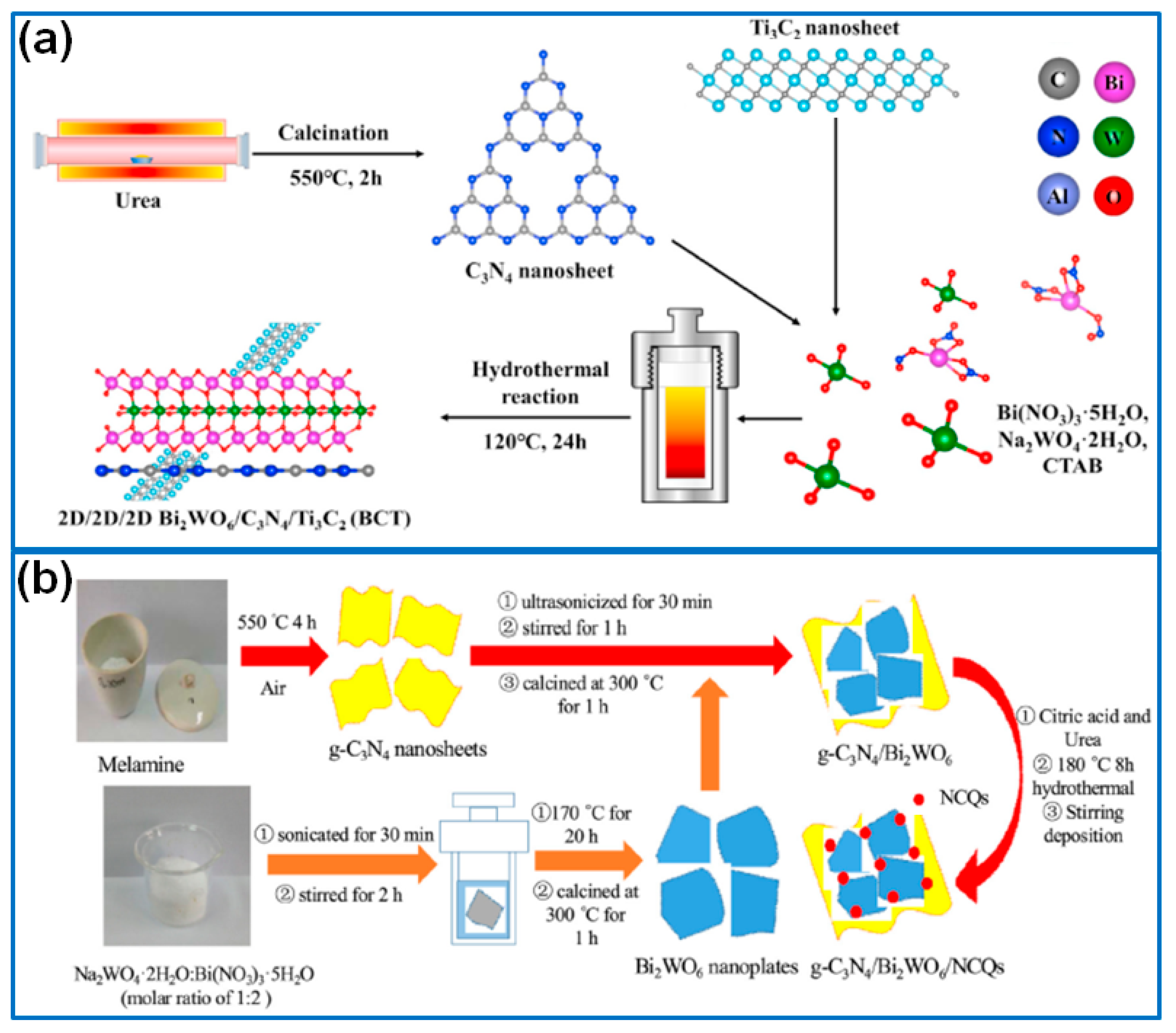Advances in Bi2WO6-Based Photocatalysts for Degradation of Organic Pollutants
Abstract
:1. Introduction
2. Morphology Control, Surface Modification, and Heteroatom Doping of Bi2WO6
2.1. Morphology Control
2.2. Surface Modification
2.3. Heteroatom Doping
3. Bi2WO6-Based Binary Composite
3.1. Bi2WO6/Carbon or MOF Composite
3.2. Bi2WO6/g-C3N4 Composite
3.3. Bi2WO6/Metal Oxides Composite
3.3.1. Bi2WO6/TiO2 Composite
3.3.2. Bi2WO6/ZnO Composite
3.3.3. Bi2WO6/Other Metal Oxides Composite
3.4. Bi2WO6/Metal Sulfides Composite
3.5. Bi2WO6/Bi-Series Composite

3.6. Bi2WO6/Metal Tungstates Composite
4. Bi2WO6-Based Ternary Composite
4.1. The Composite of Bi2WO6/g-C3N4/Other Materials
4.2. The Composite of Bi2WO6/Carbon/Other Materials
4.3. The Composite of Bi2WO6/Au or Ag-Based Materials/Other Materials
4.4. The Composite of Bi2WO6/Bi-Series Semiconductors/Other Materials
4.5. Other Composites
5. Conclusions and Prospects
- (1)
- The controllable synthesis and microstructure optimization of Bi2WO6 and Bi2WO6-based composite. The ideal microstructures of photocatalysts include hierarchical hollow structures, flowers, or spheres with a high specific surface area. Moreover, binary or ternary composites should have a strong interfacial binding strength, and the ratio optimization of different components is a major task.
- (2)
- The selection of suitable candidate semiconductor photocatalysts. The selection of semiconductors should consider the band gap feature of Bi2WO6, and the resulting Bi2WO6-based composite should form a Z-scheme, S-scheme heterojunction, or double heterojunctions. In addition, the heteroatom doping and introduction of noble metal nanoparticles can be adopted as an effective strategy for enhancing photocatalytic activity.
- (3)
- The combination of theoretical calculation and experimental results clarify the photocatalytic mechanism. The photocatalytic mechanism of the Bi2WO6-based composite is the difficulty for designing high-performance hybrid photocatalysts. Besides the traditional characterization techniques, theory computations should be paid more attention for clarifying the photocatalytic mechanism.
Author Contributions
Funding
Institutional Review Board Statement
Informed Consent Statement
Conflicts of Interest
References
- Chen, T.; Liu, L.; Hu, C.; Huang, H. Recent advances on Bi2WO6-based photocatalysts for environmental and energy applications. Chin. J. Catal. 2021, 42, 1413–1438. [Google Scholar] [CrossRef]
- Orimolade, B.O.; Idris, A.O.; Feleni, U.; Mamba, B. Recent advances in degradation of pharmaceuticals using Bi2WO6 mediated photocatalysis—A comprehensive review. Environ. Pollut. 2021, 289, 117891. [Google Scholar] [CrossRef] [PubMed]
- Duan, Z.; Zhu, Y.; Hu, Z.; Zhang, J.; Liu, D.; Luo, X.; Gao, M.; Lei, L.; Wang, X.; Zhao, G. Micro-patterned NiFe2O4/Fe–TiO2 composite films: Fabrication, hydrophilicity and application in visible-light-driven photocatalysis. Ceram. Int. 2020, 46, 27080–27091. [Google Scholar] [CrossRef]
- Chen, J.; Chen, X.; Li, N.; Liang, Y.; Yu, C.; Yao, L.; Lai, Y.; Huang, Y.; Chen, H.; Chen, Y.; et al. Enhanced photocatalytic activity of La1-xSrxCoO3/Ag3PO4 induced by the synergistic effect of doping and heterojunction. Ceram. Int. 2021, 47, 19923–19933. [Google Scholar] [CrossRef]
- Xiong, J.; Li, W.; Zhao, K.; Li, W.; Cheng, G. Engineered zinc oxide nanoaggregates for photocatalytic removal of ciprofloxacin with structure dependence. J. Nanopart. Res. 2020, 22, 155. [Google Scholar] [CrossRef]
- Wang, H.; Sun, T.; Xu, N.; Zhou, Q.; Chang, L. 2D sodium titanate nanosheet encapsulated Ag2O-TiO2 p-n heterojunction photocatalyst: Improving photocatalytic activity by the enhanced adsorption capacity. Ceram. Int. 2021, 47, 4905–4913. [Google Scholar] [CrossRef]
- Hong, X.; Li, Y.; Wang, X.; Long, J.; Liang, B. Carbon nanosheet/MnO2/BiOCl ternary composite for degradation of organic pollutants. J. Alloy. Compd. 2022, 891, 162090. [Google Scholar] [CrossRef]
- Khedr, T.M.; Wang, K.; Kowalski, D.; El-Sheikh, S.M.; Abdeldayem, H.M.; Ohtani, B.; Kowalska, E. Bi2WO6-based Z-scheme photocatalysts: Principles, mechanisms and photocatalytic applications. J. Environ. Chem. Eng. 2022, 10, 107838. [Google Scholar] [CrossRef]
- Lai, M.T.L.; Lai, C.W.; Lee, K.M.; Chook, S.W.; Yang, T.C.K.; Chong, S.H.; Juan, J.C. Facile one-pot solvothermal method to synthesize solar active Bi2WO6 for photocatalytic degradation of organic dye. J. Alloy. Compd. 2019, 801, 502–510. [Google Scholar] [CrossRef]
- Helen Selvi, M.; Reddy Vanga, P.; Ashok, A. Photocatalytic application of Bi2WO6 nanoplates structure for effective degradation of methylene blue. Optik 2018, 173, 227–234. [Google Scholar] [CrossRef]
- Guo, X.; Wu, D.; Long, X.; Zhang, Z.; Wang, F.; Ai, G.; Liu, X. Nanosheets-assembled Bi2WO6 microspheres with efficient visible-light-driven photocatalytic activities. Mater. Charact. 2020, 163, 110297. [Google Scholar] [CrossRef]
- Bai, J.; Zhang, B.; Xiong, T.; Jiang, D.; Ren, X.; Lu, P.; Fu, M. Enhanced visible light driven photocatalytic performance of Bi2WO6 nano-catalysts by introducing oxygen vacancy. J. Alloy. Compd. 2021, 887, 161297. [Google Scholar] [CrossRef]
- Chankhanittha, T.; Somaudon, V.; Photiwat, T.; Hemavibool, K.; Nanan, S. Preparation, characterization, and photocatalytic study of solvothermally grown CTAB-capped Bi2WO6 photocatalyst toward photodegradation of Rhodamine B dye. Opt. Mater. 2021, 117, 111183. [Google Scholar] [CrossRef]
- Zhou, Y.; Lv, P.; Zhang, W.; Meng, X.; He, H.; Zeng, X.; Shen, X. Pristine Bi2WO6 and hybrid Au-Bi2WO6 hollow microspheres with excellent photocatalytic activities. Appl. Surf. Sci. 2018, 457, 925–932. [Google Scholar] [CrossRef]
- Hoang, L.H.; Phu, N.D.; Peng, H.; Chen, X.B. High photocatalytic activity N-doped Bi2WO6 nanoparticles using a two-step microwave-assisted and hydrothermal synthesis. J. Alloy. Compd. 2018, 744, 228–233. [Google Scholar] [CrossRef]
- Chen, Y.; Zhang, F.; Guan, S.; Shi, W.; Wang, X.; Huang, C.; Chen, Q. Visible light degradation of tetracycline by hierarchical nanoflower structured fluorine-doped Bi2WO6. Mater. Sci. Semicon. Proc. 2022, 140, 106385. [Google Scholar] [CrossRef]
- Phuruangrat, A.; Dumrongrojthanath, P.; Thongtem, S.; Thongtem, T. Hydrothermal synthesis of I-doped Bi2WO6 for using as a visible-light-driven photocatalyst. Mater. Lett. 2018, 224, 67–70. [Google Scholar] [CrossRef]
- Hu, T.; Li, H.; Du, N.; Hou, W. Iron-Doped Bismuth Tungstate with an Excellent Photocatalytic Performance. ChemCatChem 2018, 10, 3040–3048. [Google Scholar] [CrossRef]
- Arif, M.; Zhang, M.; Yao, J.; Yin, H.; Li, P.; Hussain, I.; Liu, X. Layer-assembled 3D Bi2WO6 hierarchical architectures by Ti-doping for enhanced visible-light driven photocatalytic and photoelectrochemical performance. J. Alloy. Compd. 2019, 792, 878–893. [Google Scholar] [CrossRef]
- Maniyazagan, M.; Hussain, M.; Kang, W.S.; Kim, S.J. Hierarchical Sr-Bi2WO6 photocatalyst for the degradation of 4-nitrophenol and methylene blue. J. Ind. Eng. Chem. 2022, 110, 168–177. [Google Scholar] [CrossRef]
- Qiu, Y.; Lu, J.; Yan, Y.; Niu, J. Enhanced visible-light-driven photocatalytic degradation of tetracycline by 16% Er3+-Bi2WO6 photocatalyst. J. Hazard. Mater. 2022, 422, 126920. [Google Scholar] [CrossRef] [PubMed]
- Ning, J.; Zhang, J.; Dai, R.; Wu, Q.; Zhang, L.; Zhang, W.; Yan, J.; Zhang, F. Experiment and DFT study on the photocatalytic properties of La-doped Bi2WO6 nanoplate-like materials. Appl. Surf. Sci. 2022, 579, 152219. [Google Scholar] [CrossRef]
- Phuruangrat, A.; Buapoon, S.; Bunluesak, T.; Suebsom, P.; Wannapop, S.; Thongtem, T.; Thongtem, S. Hydrothermal preparation of Au-doped Bi2WO6 nanoplates for enhanced visible-light-driven photocatalytic degradation of rhodamine B. Solid State Sci. 2022, 128, 106881. [Google Scholar] [CrossRef]
- Phu, N.D.; Hoang, L.H.; Van Hai, P.; Huy, T.Q.; Chen, X.B.; Chou, W.C. Photocatalytic activity enhancement of Bi2WO6 nanoparticles by Ag doping and Ag nanoparticles modification. J. Alloy. Compd. 2020, 824, 153914. [Google Scholar] [CrossRef]
- Longchin, P.; Sakulsermsuk, S.; Wetchakun, K.; Wetchakun, N. Synergistic effect of La and Mo co-doping on the enhanced photocatalytic activity of Bi2WO6. Mater. Lett. 2021, 305, 130779. [Google Scholar] [CrossRef]
- Zhao, Y.; Liang, X.; Hu, X.; Fan, J. rGO/Bi2WO6 composite as a highly efficient and stable visible-light photocatalyst for norfloxacin degradation in aqueous environment. J. Colloid Interface Sci. 2021, 589, 336–346. [Google Scholar] [CrossRef] [PubMed]
- Arya, M.; Kaur, M.; Kaur, A.; Singh, S.; Devi, P.; Kansal, S.K. Hydrothermal synthesis of rGO-Bi2WO6 heterostructure for the photocatalytic degradation of levofloxacin. Opt. Mater. 2020, 107, 110126. [Google Scholar] [CrossRef]
- Yue, L.; Wang, S.; Shan, G.; Wu, W.; Qiang, L.; Zhu, L. Novel MWNTs–Bi2WO6 composites with enhanced simulated solar photoactivity toward adsorbed and free tetracycline in water. Appl. Catal. B-Environ. 2015, 176–177, 11–19. [Google Scholar] [CrossRef]
- Yan, F.; Wang, Y.; Yi, C.; Xu, J.; Wang, B.; Ma, R.; Xu, M. Construction of carbon dots modified Cl-doped Bi2WO6 hollow microspheres for boosting photocatalytic degradation of tetracycline under visible light irradiation. Ceram. Int. 2022, in press. [Google Scholar] [CrossRef]
- Liang, W.; Pan, J.; Duan, X.; Tang, H.; Xu, J.; Tang, G. Biomass carbon modified flower-like Bi2WO6 hierarchical architecture with improved photocatalytic performance. Ceram. Int. 2020, 46, 3623–3630. [Google Scholar] [CrossRef]
- Wang, T.; Liu, S.; Mao, W.; Bai, Y.; Chiang, K.; Shah, K.; Paz-Ferreiro, J. Novel Bi2WO6 loaded N-biochar composites with enhanced photocatalytic degradation of rhodamine B and Cr(VI). J. Hazard. Mater. 2020, 389, 121827. [Google Scholar] [CrossRef] [PubMed]
- Mao, W.; Zhang, L.; Liu, Y.; Wang, T.; Bai, Y.; Guan, Y. Facile assembled N, S-codoped corn straw biochar loaded Bi2WO6 with the enhanced electron-rich feature for the efficient photocatalytic removal of ciprofloxacin and Cr(VI). Chemosphere 2021, 263, 127988. [Google Scholar] [CrossRef] [PubMed]
- Kaur, M.; Mehta, S.K.; Devi, P.; Kansal, S.K. Bi2WO6/NH2-MIL-88B(Fe) heterostructure: An efficient sunlight driven photocatalyst for the degradation of antibiotic tetracycline in aqueous medium. Adv. Powder Technol. 2021, 32, 4788–4804. [Google Scholar] [CrossRef]
- He, Y.; Wang, D.; Li, X.; Fu, Q.; Yin, L.; Yang, Q.; Chen, H. Photocatalytic degradation of tetracycline by metal-organic frameworks modified with Bi2WO6 nanosheet under direct sunlight. Chemosphere 2021, 284, 131386. [Google Scholar] [CrossRef]
- Li, Q.; Li, L.; Long, X.; Tu, Y.; Ling, L.; Gu, J.; Hou, L.; Xu, Y.; Liu, N.; Li, Z. Rational design of MIL-88A(Fe)/Bi2WO6 heterojunctions as an efficient photocatalyst for organic pollutant degradation under visible light irradiation. Opt. Mater. 2021, 118, 111260. [Google Scholar] [CrossRef]
- Tu, Y.; Ling, L.; Li, Q.; Long, X.; Liu, N.; Li, Z. Greatly enhanced photocatalytic activity over Bi2WO6 by MIL-53(Fe) modification. Opt. Mater. 2020, 110, 110500. [Google Scholar] [CrossRef]
- Zhang, X.; Yuan, N.; Chen, T.; Li, B.; Wang, Q. Fabrication of hydrangea-shaped Bi2WO6/ZIF-8 visible-light responsive photocatalysts for degradation of methylene blue. Chemosphere 2022, 307, 135949. [Google Scholar] [CrossRef]
- Dai, X.; Feng, S.; Wu, W.; Zhou, Y.; Ye, Z.; Wang, Y.; Cao, X. Photocatalytic Degradation of Tetracycline by Z-Scheme Bi2WO6/ZIF-8. J. Inorg. Organomet. Polym. Mater. 2022, 32, 2371–2383. [Google Scholar] [CrossRef]
- Qi, S.; Zhang, R.; Zhang, Y.; Liu, X.; Xu, H. Preparation and photocatalytic properties of Bi2WO6/g-C3N4. Inorg. Chem. Commun. 2021, 132, 108761. [Google Scholar] [CrossRef]
- Zhao, Y.; Liang, X.; Wang, Y.; Shi, H.; Liu, E.; Fan, J.; Hu, X. Degradation and removal of Ceftriaxone sodium in aquatic environment with Bi2WO6/g-C3N4 photocatalyst. J. Colloid Interface Sci. 2018, 523, 7–17. [Google Scholar] [CrossRef]
- Chen, J.; Yang, Q.; Zhong, J.; Li, J.; Hu, C.; Deng, Z.; Duan, R. In-situ construction of direct Z-scheme Bi2WO6/ g-C3N4 composites with remarkably promoted solar-driven photocatalytic activity. Mater. Chem. Phys. 2018, 217, 207–215. [Google Scholar] [CrossRef]
- Zhu, D.; Zhou, Q. Novel Bi2WO6 modified by N-doped graphitic carbon nitride photocatalyst for efficient photocatalytic degradation of phenol under visible light. Appl. Catal. B-Environ. 2020, 268, 118426. [Google Scholar] [CrossRef]
- Wang, Y.; Jiang, W.; Luo, W.; Chen, X.; Zhu, Y. Ultrathin nanosheets g-C3N4@Bi2WO6 core-shell structure via low temperature reassembled strategy to promote photocatalytic activity. Appl. Catal. B-Environ. 2018, 237, 633–640. [Google Scholar] [CrossRef]
- Zhang, M.; Zhang, Y.; Tang, L.; Zeng, G.; Wang, J.; Zhu, Y.; Feng, C.; Deng, Y.; He, W. Ultrathin Bi2WO6 nanosheets loaded g-C3N4 quantum dots: A direct Z-scheme photocatalyst with enhanced photocatalytic activity towards degradation of organic pollutants under wide spectrum light irradiation. J. Colloid Interface Sci. 2019, 539, 654–664. [Google Scholar] [CrossRef] [PubMed]
- Gordanshekan, A.; Arabian, S.; Solaimany Nazar, A.R.; Farhadian, M.; Tangestaninejad, S. A comprehensive comparison of green Bi2WO6/g-C3N4 and Bi2WO6/TiO2 S-scheme heterojunctions for photocatalytic adsorption/ degradation of Cefixime: Artificial neural network, degradation pathway, and toxicity estimation. Chem. Eng. J. 2023, 451, 139067. [Google Scholar] [CrossRef]
- Li, W.; Ding, X.; Wu, H.; Yang, H. In-situ hydrothermal synthesis of TiO2/Bi2WO6 heterojunction with enhanced photocatalytic activity. Mater. Lett. 2018, 227, 272–275. [Google Scholar] [CrossRef]
- Chen, G.; Wang, Y.; Shen, Q.; Xiong, X.; Ren, S.; Dai, G.; Wu, C. Fabrication of TiO2 nanofibers assembled by Bi2WO6 nanosheets with enhanced visible light photocatalytic activity. Ceram. Int. 2020, 46, 21304–21310. [Google Scholar] [CrossRef]
- Lu, Q.; Dong, C.; Wei, F.; Li, J.; Wang, Z.; Mu, W.; Han, X. Rational fabrication of Bi2WO6 decorated TiO2 nanotube arrays for photocatalytic degradation of organic pollutants. Mater. Res. Bull. 2022, 145, 111563. [Google Scholar] [CrossRef]
- Wang, Q.; Li, H.; Yu, X.; Jia, Y.; Chang, Y.; Gao, S. Morphology regulated Bi2WO6 nanoparticles on TiO2 nanotubes by solvothermal Sb3+ doping as effective photocatalysts for wastewater treatment. Electrochim. Acta 2020, 330, 135167. [Google Scholar] [CrossRef]
- Sun, M.; Yao, Y.; Ding, W.; Anandan, S. N/Ti3+ co-doping biphasic TiO2/Bi2WO6 heterojunctions: Hydrothermal fabrication and sonophotocatalytic degradation of organic pollutants. J. Alloy. Compd. 2020, 820, 153172. [Google Scholar] [CrossRef]
- Liu, J.; Luo, Z.; Han, W.; Zhao, Y.; Li, P. Preparation of ZnO/Bi2WO6 heterostructures with improved photocatalytic performance. Mater. Sci. Semicon. Proc. 2020, 106, 104761. [Google Scholar] [CrossRef]
- Koutavarapu, R.; Babu, B.; Reddy, C.V.; Reddy, I.N.; Reddy, K.R.; Rao, M.C.; Aminabhavi, T.M.; Cho, M.; Kim, D.; Shim, J. ZnO nanosheets-decorated Bi2WO6 nanolayers as efficient photocatalysts for the removal of toxic environmental pollutants and photoelectrochemical solar water oxidation. J. Environ. Manag. 2020, 265, 110504. [Google Scholar] [CrossRef] [PubMed]
- Chen, X.; Li, J.; Chen, F. Photocatalytic degradation of MB by novel and environmental ZnO/Bi2WO6-CC hierarchical heterostructures. Mater. Charact. 2022, 189, 111961. [Google Scholar] [CrossRef]
- Zhao, F.; Gao, D.; Zhu, X.; Dong, Y.; Liu, X.; Li, H. Rational design of multifunctional C/N-doped ZnO/Bi2WO6 Z-scheme heterojunction for efficient photocatalytic degradation of antibiotics. Appl. Surf. Sci. 2022, 587, 152780. [Google Scholar] [CrossRef]
- Salari, H.; Yaghmaei, H. Z-scheme 3D Bi2WO6/MnO2 heterojunction for increased photoinduced charge separation and enhanced photocatalytic activity. Appl. Surf. Sci. 2020, 532, 147413. [Google Scholar] [CrossRef]
- Mallikarjuna, K.; Kim, H. Bandgap-tuned ultra-small SnO2-nanoparticle-decorated 2D-Bi2WO6 nanoplates for visible-light-driven photocatalytic applications. Chemosphere 2021, 263, 128185. [Google Scholar] [CrossRef]
- Zhu, B.; Song, D.; Jia, T.; Sun, W.; Wang, D.; Wang, L.; Guo, J.; Jin, L.; Zhang, L.; Tao, H. Effective Visible Light-Driven Photocatalytic Degradation of Ciprofloxacin over Flower-like Fe3O4/Bi2WO6 Composites. ACS Omega 2021, 6, 1647–1656. [Google Scholar] [CrossRef]
- Zhang, X.; Zhang, H.; Yu, J.; Wu, Z.; Zhou, Q. Preparation of flower-like Co3O4 QDs/Bi2WO6 p-n heterojunction photocatalyst and its degradation mechanism of efficient visible-light-driven photocatalytic tetracycline antibiotics. Appl. Surf. Sci. 2022, 585, 152547. [Google Scholar] [CrossRef]
- Koutavarapu, R.; Syed, K.; Pagidi, S.; Jeon, M.Y.; Rao, M.C.; Lee, D.Y.; Shim, J. An effective CuO/Bi2WO6 heterostructured photocatalyst: Analyzing a charge-transfer mechanism for the enhanced visible-light-driven photocatalytic degradation of tetracycline and organic pollutants. Chemosphere 2022, 287, 132015. [Google Scholar] [CrossRef]
- Chen, X.; Li, Y.; Li, L. Facet-engineered surface and interface design of WO3/Bi2WO6 photocatalyst with direct Z-scheme heterojunction for efficient salicylic acid removal. Appl. Surf. Sci. 2020, 508, 144796. [Google Scholar] [CrossRef]
- Liu, G.; Cui, P.; Liu, X.; Wang, X.; Liu, G.; Zhang, C.; Liu, M.; Chen, Y.; Xu, S. A facile preparation strategy for Bi2O4/Bi2WO6 heterojunction with excellent visible light photocatalytic activity. J. Solid State Chem. 2020, 290, 121542. [Google Scholar] [CrossRef]
- Chao, P.Y.; Chang, C.J.; Lin, K.S.; Wang, C.F. Synergistic effects of morphology control and calcination on the activity of flower-like Bi2WO6-Bi2O3 photocatalysts prepared by an ionic liquid-assisted solvothermal method. J. Alloy. Compd. 2021, 883, 160920. [Google Scholar] [CrossRef]
- Qin, Y.; Li, H.; Lu, J.; Ding, Y.; Ma, C.; Liu, X.; Meng, M.; Yan, Y. Fabrication of Bi2WO6/In2O3 photocatalysts with efficient photocatalytic performance for the degradation of organic pollutants: Insight into the role of oxygen vacancy and heterojunction. Adv. Powder Technol. 2020, 31, 2890–2900. [Google Scholar] [CrossRef]
- Tang, Q.Y.; Chen, W.F.; Lv, Y.R.; Yang, S.Y.; Xu, Y.H. Z-scheme hierarchical Cu2S/Bi2WO6 composites for improved photocatalytic activity of glyphosate degradation under visible light irradiation. Sep. Purif. Technol. 2020, 236, 116243. [Google Scholar] [CrossRef]
- Zhang, Y.; Ju, P.; Hao, L.; Zhai, X.; Jiang, F.; Sun, C. Novel Z-scheme MoS2/Bi2WO6 heterojunction with highly enhanced photocatalytic activity under visible light irradiation. J. Alloy. Compd. 2021, 854, 157224. [Google Scholar] [CrossRef]
- Xie, T.; Liu, Y.; Wang, H.; Wu, Z. Layered MoSe2/Bi2WO6 composite with P-N heterojunctions as a promising visible-light induced photocatalyst. Appl. Surf. Sci. 2018, 444, 320–329. [Google Scholar] [CrossRef]
- Kumar, G.; Dutta, R.K. Fabrication of plate-on-plate SnS2/Bi2WO6 nanocomposite as photocatalyst for sunlight mediated degradation of antibiotics in aqueous medium. J. Phys. Chem. Solids 2022, 164, 110639. [Google Scholar] [CrossRef]
- Su, M.; Sun, H.; Tian, Z.; Zhao, Z.; Li, P. Z-scheme 2D/2D WS2/Bi2WO6 heterostructures with enhanced photocatalytic performance. Appl. Catal. A-Gen. 2022, 631, 118485. [Google Scholar] [CrossRef]
- Su, Y.; Xu, X.; Li, R.; Luo, X.; Yao, H.; Fang, S.; Peter Homewood, K.; Huang, Z.; Gao, Y.; Chen, X. Design and fabrication of a CdS QDs/Bi2WO6 monolayer S-scheme heterojunction configuration for highly efficient photocatalytic degradation of trace ethylene in air. Chem. Eng. J. 2022, 429, 132241. [Google Scholar] [CrossRef]
- Zhang, Z.; Lin, Y.; Liu, F. Preparation and photocatalytic performance of CdS@Bi2WO6 hybrid nanocrystals. J. Alloy. Compd. 2021, 889, 161668. [Google Scholar] [CrossRef]
- Xu, F.; Xu, C.; Chen, H.; Wu, D.; Gao, Z.; Ma, X.; Zhang, Q.; Jiang, K. The synthesis of Bi2S3/2D-Bi2WO6 composite materials with enhanced photocatalytic activities. J. Alloy. Compd. 2019, 780, 634–642. [Google Scholar] [CrossRef]
- He, Z.; Siddique, M.S.; Yang, H.; Xia, Y.; Su, J.; Tang, B.; Wang, L.; Kang, L.; Huang, Z. Novel Z-scheme In2S3/ Bi2WO6 core-shell heterojunctions with synergistic enhanced photocatalytic degradation of tetracycline hydrochloride. J. Clean. Prod. 2022, 339, 130634. [Google Scholar] [CrossRef]
- Lu, X.; Che, W.; Hu, X.; Wang, Y.; Zhang, A.; Deng, F.; Luo, S.; Dionysiou, D.D. The facile fabrication of novel visible-light-driven Z-scheme CuInS2/Bi2WO6 heterojunction with intimate interface contact by in situ hydrothermal growth strategy for extraordinary photocatalytic performance. Chem. Eng. J. 2019, 356, 819–829. [Google Scholar] [CrossRef]
- Shangguan, X.Y.; Fang, B.L.; Xu, C.X.; Tan, Y.; Chen, Y.G.; Xia, Z.J.; Chen, W. Fabrication of direct Z-scheme FeIn2S4/Bi2WO6 hierarchical heterostructures with enhanced photocatalytic activity for tetracycline hydrochloride photodagradation. Ceram. Int. 2021, 47, 6318–6328. [Google Scholar] [CrossRef]
- Guo, M.; Zhou, Z.; Yan, S.; Zhou, P.; Miao, F.; Liang, S.; Wang, J.; Cui, X. Bi2WO6-BiOCl heterostructure with enhanced photocatalytic activity for efficient degradation of oxytetracycline. Sci. Rep. 2020, 10, 18401. [Google Scholar] [CrossRef]
- Liang, Z.; Zhou, C.; Yang, J.; Mo, Q.; Zhang, Y.; Tang, Y. Visible light responsive Bi2WO6/BiOCl heterojunction with enhanced photocatalytic activity for degradation of tetracycline and rohdamine B. Inorg. Chem. Commun. 2018, 93, 136–139. [Google Scholar] [CrossRef]
- Liu, K.; Zhang, H.; Muhammad, Y.; Fu, T.; Tang, R.; Tong, Z.; Wang, Y. Fabrication of n-n isotype BiOBr- Bi2WO6 heterojunctions by inserting Bi2WO6 nanosheets onto BiOBr microsphere for the superior photocatalytic degradation of Ciprofloxacin and tetracycline. Sep. Purif. Technol. 2021, 274, 118992. [Google Scholar] [CrossRef]
- Ren, X.; Wu, K.; Qin, Z.; Zhao, X.; Yang, H. The construction of type II heterojunction of Bi2WO6/BiOBr photocatalyst with improved photocatalytic performance. J. Alloy. Compd. 2019, 788, 102–109. [Google Scholar] [CrossRef]
- Chen, X.; Zhao, B.; Ma, J.; Liu, L.; Luo, H.; Wang, W. The BiOBr/Bi/Bi2WO6 photocatalyst with SPR effect and Z-scheme heterojunction synergistically degraded RhB under visible light. Opt. Mater. 2021, 122, 111641. [Google Scholar] [CrossRef]
- He, J.; Liu, Y.; Wang, M.; Wang, Y.; Long, F. Ionic liquid-hydrothermal synthesis of Z-scheme BiOBr/Bi2WO6 heterojunction with enhanced photocatalytic activity. J. Alloy. Compd. 2021, 865, 158760. [Google Scholar] [CrossRef]
- Huang, X.; Guo, Q.; Yan, B.; Liu, H.; Chen, K.; Wei, S.; Wu, Y.; Wang, L. Study on photocatalytic degradation of phenol by BiOI/Bi2WO6 layered heterojunction synthesized by hydrothermal method. J. Mol. Liq. 2021, 322, 114965. [Google Scholar] [CrossRef]
- Zheng, X.; Chu, Y.; Miao, B.; Fan, J. Ag-doped Bi2WO6/BiOI heterojunction used as photocatalyst for the enhanced degradation of tetracycline under visible-light and biodegradability improvement. J. Alloy. Compd. 2022, 893, 162382. [Google Scholar] [CrossRef]
- Qiang, Z.; Liu, X.; Li, F.; Li, T.; Zhang, M.; Singh, H.; Huttula, M.; Cao, W. Iodine doped Z-scheme Bi2O2CO3/ Bi2WO6 photocatalysts: Facile synthesis, efficient visible light photocatalysis, and photocatalytic mechanism. Chem. Eng. J. 2021, 403, 126327. [Google Scholar] [CrossRef]
- Wu, R.; Song, H.; Luo, N.; Ji, G. Hydrothermal preparation of 3D flower-like BiPO4/Bi2WO6 microsphere with enhanced visible-light photocatalytic activity. J. Colloid Interface Sci. 2018, 524, 350–359. [Google Scholar] [CrossRef] [PubMed]
- Zhang, Y.; Xu, C.; Wan, F.; Zhou, D.; Yang, L.; Gu, H.; Xiong, J. Synthesis of flower-like Bi2Sn2O7/Bi2WO6 hierarchical composites with enhanced visible light photocatalytic performance. J. Alloy. Compd. 2019, 788, 1154–1161. [Google Scholar] [CrossRef]
- Tao, R.; Li, X.; Li, X.; Liu, S.; Shao, C.; Liu, Y. Discrete heterojunction nanofibers of BiFeO3/Bi2WO6: Novel architecture for effective charge separation and enhanced photocatalytic performance. J. Colloid Interface Sci. 2020, 572, 257–268. [Google Scholar] [CrossRef]
- Teng, P.; Li, Z.; Gao, S.; Li, K.; Bowkett, M.; Copner, N.; Liu, Z.; Yang, X. Fabrication of one-dimensional Bi2WO6/CuBi2O4 heterojunction nanofiber and its photocatalytic degradation property. Opt. Mater. 2021, 121, 111508. [Google Scholar] [CrossRef]
- Wang, L.; Yang, G.; Wang, D.; Lu, C.; Guan, W.; Li, Y.; Deng, J.; Crittenden, J. Fabrication of the flower-flake- like CuBi2O4/Bi2WO6 heterostructure as efficient visible-light driven photocatalysts: Performance, kinetics and mechanism insight. Appl. Surf. Sci. 2019, 495, 143521. [Google Scholar] [CrossRef]
- Kumar, P.; Verma, S.; Korošin, N.Č.; Žener, B.; Štangar, U.L. Increasing the photocatalytic efficiency of ZnWO4 by synthesizing a Bi2WO6/ZnWO4 composite photocatalyst. Catal. Today 2022, 397–399, 278–285. [Google Scholar] [CrossRef]
- Miao, B.; Chu, Y.; Zheng, X.; Su, H. Sb2WO6/Bi2WO6 composite photocatalyst prepared by one-step hydrothermal method: Simple synthesis and excellent visible-light photocatalytic performance. Mater. Sci. Semicon. Proc. 2021, 125, 105636. [Google Scholar] [CrossRef]
- Ni, Z.; Shen, Y.; Xu, L.; Xiang, G.; Chen, M.; Shen, N.; Li, K.; Ni, K. Facile construction of 3D hierarchical flower- like Ag2WO4/Bi2WO6 Z-scheme heterojunction photocatalyst with enhanced visible light photocatalytic activity. Appl. Surf. Sci. 2022, 576, 151868. [Google Scholar] [CrossRef]
- Zhang, R.; Zeng, K. A novel flower-like dual Z-scheme BiSI/Bi2WO6/g-C3N4 photocatalyst has excellent photocatalytic activity for the degradation of organic pollutants under visible light. Diam. Relat. Mater. 2021, 115, 108343. [Google Scholar] [CrossRef]
- Sun, H.; Zou, C.; Tang, W. Designing double Z-scheme heterojunction of g-C3N4/Bi2MoO6/Bi2WO6 for efficient visible-light photocatalysis of organic pollutants. Colloids Surf. A 2022, 654, 130105. [Google Scholar] [CrossRef]
- Zhou, K.; Liu, Y.; Hao, J. One-pot hydrothermal synthesis of dual Z-scheme BiOBr/g-C3N4/Bi2WO6 and photocatalytic degradation of tetracycline under visible light. Mater. Lett. 2020, 281, 128463. [Google Scholar] [CrossRef]
- Chu, Y.; Fan, J.; Wang, R.; Liu, C.; Zheng, X. Preparation and immobilization of Bi2WO6/BiOI/g-C3N4 nanoparticles for the photocatalytic degradation of tetracycline and municipal waste transfer station leachate. Sep. Purif. Technol. 2022, 300, 121867. [Google Scholar] [CrossRef]
- Hu, H.; Kong, W.; Wang, J.; Liu, C.; Cai, Q.; Kong, Y.; Zhou, S.; Yang, Z. Engineering 2D compressed layered g-C3N4 nanosheets by the intercalation of BiVO4-Bi2WO6 composites for boosting photocatalytic activities. Appl. Surf. Sci. 2021, 557, 149796. [Google Scholar] [CrossRef]
- Wu, K.; Song, S.; Wu, H.; Guo, J.; Zhang, L. Facile synthesis of Bi2WO6/C3N4/Ti3C2 composite as Z-scheme photocatalyst for efficient ciprofloxacin degradation and H2 production. Appl.Catal. A-Gen. 2020, 608, 117869. [Google Scholar] [CrossRef]
- Li, Q.; Lu, M.; Wang, W.; Zhao, W.; Chen, G.; Shi, H. Fabrication of 2D/2D g-C3N4/Au/Bi2WO6 Z-scheme photocatalyst with enhanced visible-light-driven photocatalytic activity. Appl. Surf. Sci. 2020, 508, 144182. [Google Scholar] [CrossRef]
- Jia, J.; Zhang, X.; Jiang, C.; Huang, W.; Wang, Y. Visible-light-driven nitrogen-doped carbon quantum dots decorated g-C3N4/Bi2WO6 Z-scheme composite with enhanced photocatalytic activity and mechanism insight. J. Alloy. Compd. 2020, 835, 155180. [Google Scholar] [CrossRef]
- Guan, Z.; Li, X.; Wu, Y.; Chen, Z.; Huang, X.; Wang, D.; Yang, Q.; Liu, J.; Tian, S.; Chen, X.; et al. AgBr nanoparticles decorated 2D/2D GO/Bi2WO6 photocatalyst with enhanced photocatalytic performance for the removal of tetracycline hydrochloride. Chem. Eng. J. 2021, 410, 128283. [Google Scholar] [CrossRef]
- Mengting, Z.; Kurniawan, T.A.; Yanping, Y.; Avtar, R.; Othman, M.H.D. 2D Graphene oxide (GO) doped p-n type BiOI/Bi2WO6 as a novel composite for photodegradation of bisphenol A (BPA) in aqueous solutions under UV-vis irradiation. Mater. Sci. Eng. C-Mater. 2020, 108, 110420. [Google Scholar] [CrossRef] [PubMed]
- Tian, J.; Zhu, Z.; Liu, B. Novel Bi2MoO6/Bi2WO6/MWCNTs photocatalyst with enhanced photocatalytic activity towards degradation of RB-19 under visible light irradiation. Colloid. Surf. A 2019, 581, 123798. [Google Scholar] [CrossRef]
- Niu, J.; Song, Z.; Gao, X.; Ji, Y.; Zhang, Y. Construction of Bi2WO6 composites with carbon-coated Cu2O for effective degradation of tetracycline. J. Alloy. Compd. 2021, 884, 161292. [Google Scholar] [CrossRef]
- Wang, X.; Liu, X.; Li, H.; Yang, Y.; Ren, Y. Ag2CO3/AgBr/Bi2WO6 nanocomposite: Synthesis and solar photocatalytic activity. Inorg. Chem. Commun. 2021, 132, 108826. [Google Scholar] [CrossRef]
- Gan, W.; Zhang, J.; Niu, H.; Bao, L.; Hao, H.; Yan, Y.; Wu, K.; Fu, X. Fabrication of Ag/AgBr/Bi2WO6 hierarchical composites with high visible light photocatalytic activity. Chem. Phys. Lett. 2019, 737, 136830. [Google Scholar] [CrossRef]
- Jin, K.; Qin, M.; Li, X.; Wang, R.; Zhao, Y.; Wang, H. Z-scheme Au@TiO2/Bi2WO6 heterojunction as efficient visible-light photocatalyst for degradation of antibiotics. J. Mol. Liq. 2022, 364, 120017. [Google Scholar] [CrossRef]
- Mengting, Z.; Kurniawan, T.A.; Yanping, Y.; Dzarfan Othman, M.H.; Avtar, R.; Fu, D.; Hwang, G.H. Fabrication, characterization, and application of ternary magnetic recyclable Bi2WO6/BiOI@Fe3O4 composite for photodegradation of tetracycline in aqueous solutions. J. Environ. Manag. 2020, 270, 110839. [Google Scholar] [CrossRef]
- Chen, Y.; Su, X.; Ma, M.; Hou, Y.; Lu, C.; Wan, F.; Ma, Y.; Xu, Z.; Liu, Q.; Hao, M.; et al. One- dimensional magnetic flower-like CoFe2O4@Bi2WO6@BiOBr composites for visible-light catalytic degradation of Rhodamine B. J. Alloy. Compd. 2022, 929, 167297. [Google Scholar] [CrossRef]
- Rao, C.; Zhou, L.; Pan, Y.; Lu, C.; Qin, X.; Sakiyama, H.; Muddassir, M.; Liu, J. The extra-large calixarene-based MOFs-derived hierarchical composites for photocatalysis of dye: Facile syntheses and contribution of carbon species. J. Alloy. Compd. 2022, 897, 163178. [Google Scholar] [CrossRef]
- Jin, J.C.; Wang, J.; Guo, J.; Yan, M.H.; Wang, J.; Srivastava, D.; Kumar, A.; Sakiyama, H.; Muddassir, M.; Pan, Y. A 3D rare cubane-like tetramer Cu(II)-based MOF with 4-fold dia topology as an efficient photocatalyst for dye degradation. Colloid. Surf. A 2023, 656, 130475. [Google Scholar] [CrossRef]
- Li, L.; Zou, J.; Han, Y.; Liao, Z.; Lu, P.; Nezamzadeh-Ejhieh, A.; Liu, J.; Peng, Y. Recent advances in Al(iii)/In(iii)-based MOFs for the detection of pollutants. New J. Chem. 2022, 46, 19577–19592. [Google Scholar] [CrossRef]
- Sharma, V.; Kumar, A.; Kumar, A.; Krishnan, V. Enhanced photocatalytic activity of two dimensional ternary nanocomposites of ZnO-Bi2WO6-Ti3C2 MXene under natural sunlight irradiation. Chemosphere 2022, 287, 132119. [Google Scholar] [CrossRef] [PubMed]
- Ma, Q.; Ming, J.; Sun, X.; Liu, N.; Chen, G.; Yang, Y. Visible light active graphene oxide modified Ag/Ag2O/ BiPO4/Bi2WO6 for photocatalytic removal of organic pollutants and bacteria in wastewater. Chemosphere 2022, 306, 135512. [Google Scholar] [CrossRef] [PubMed]
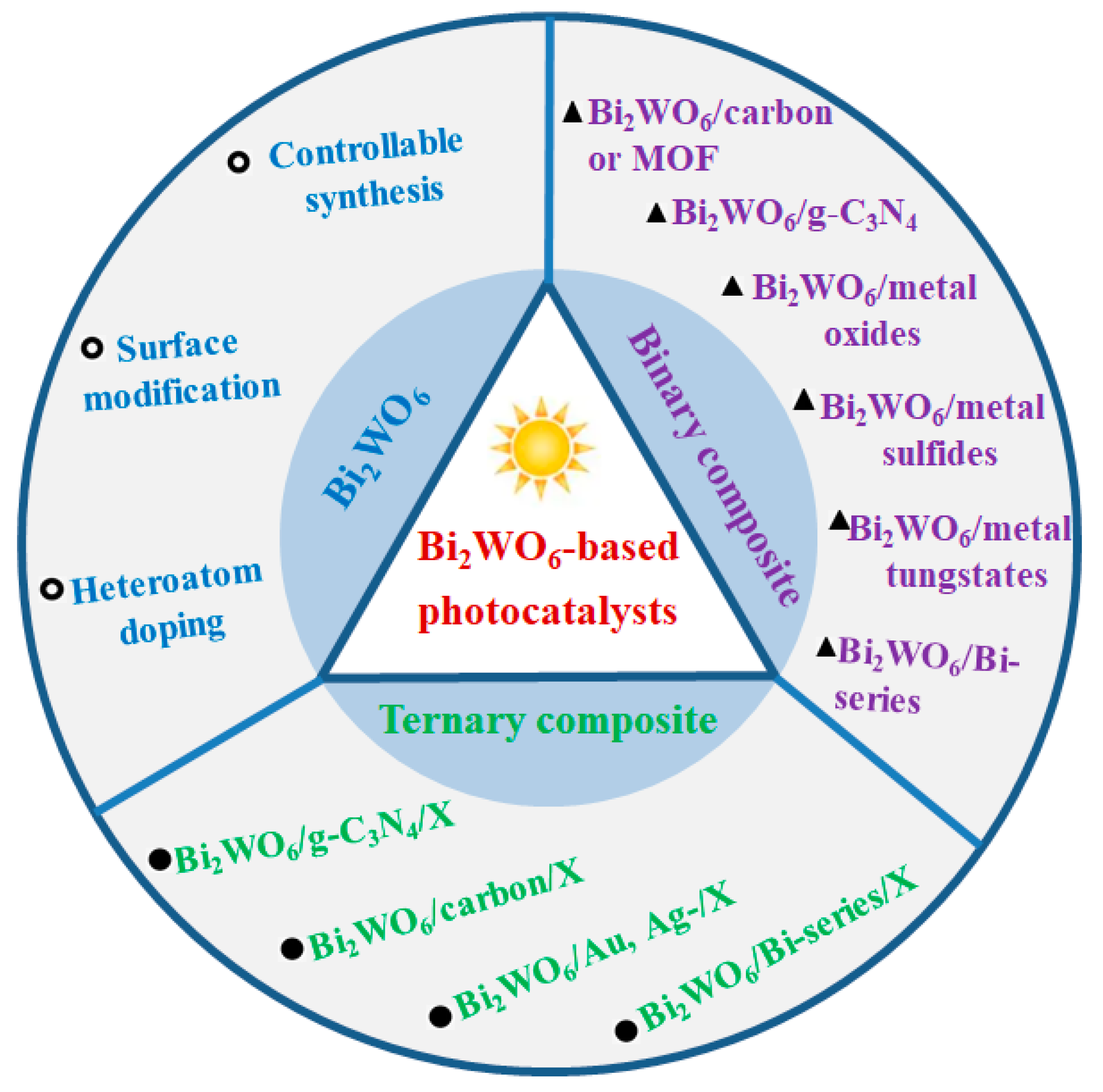
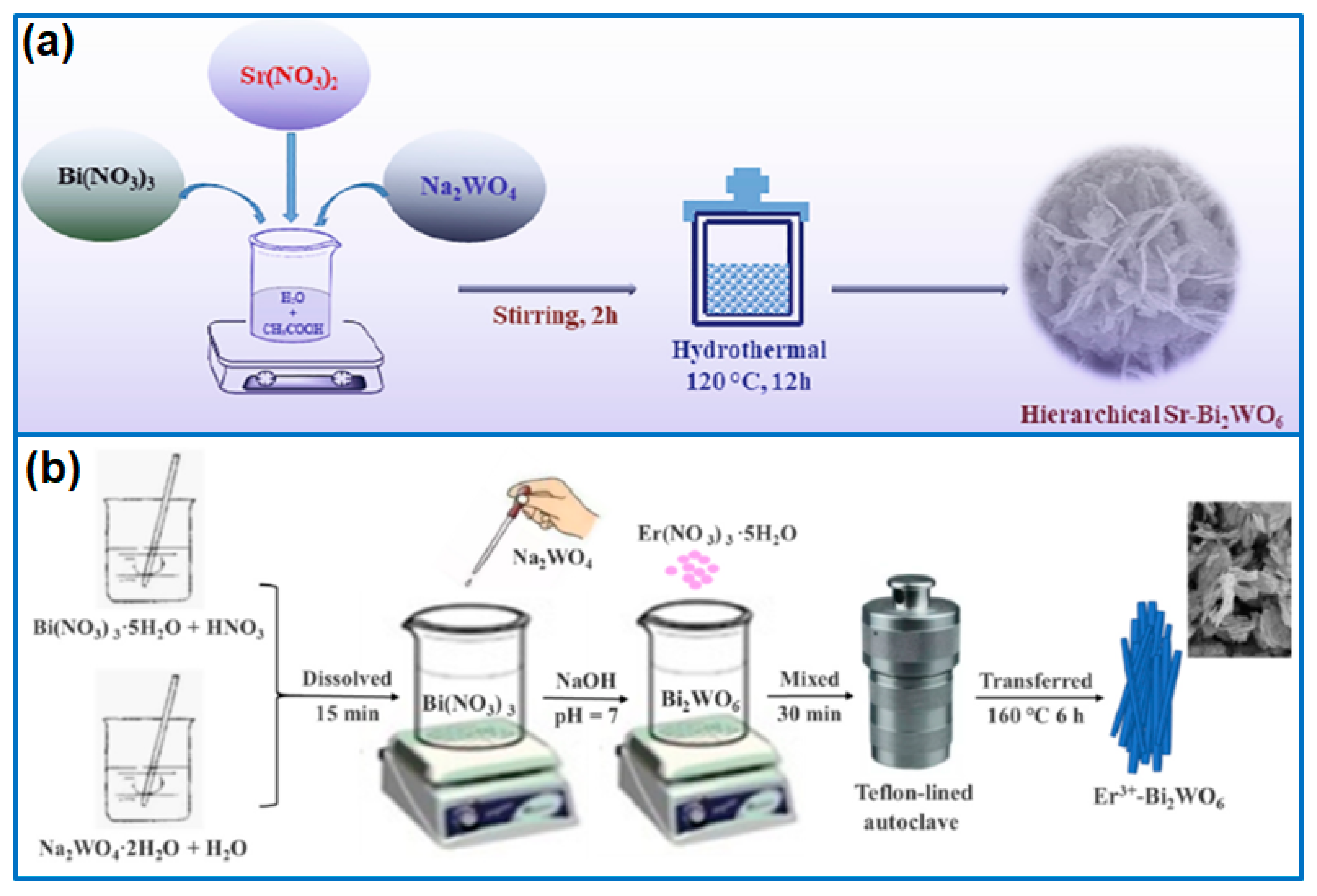
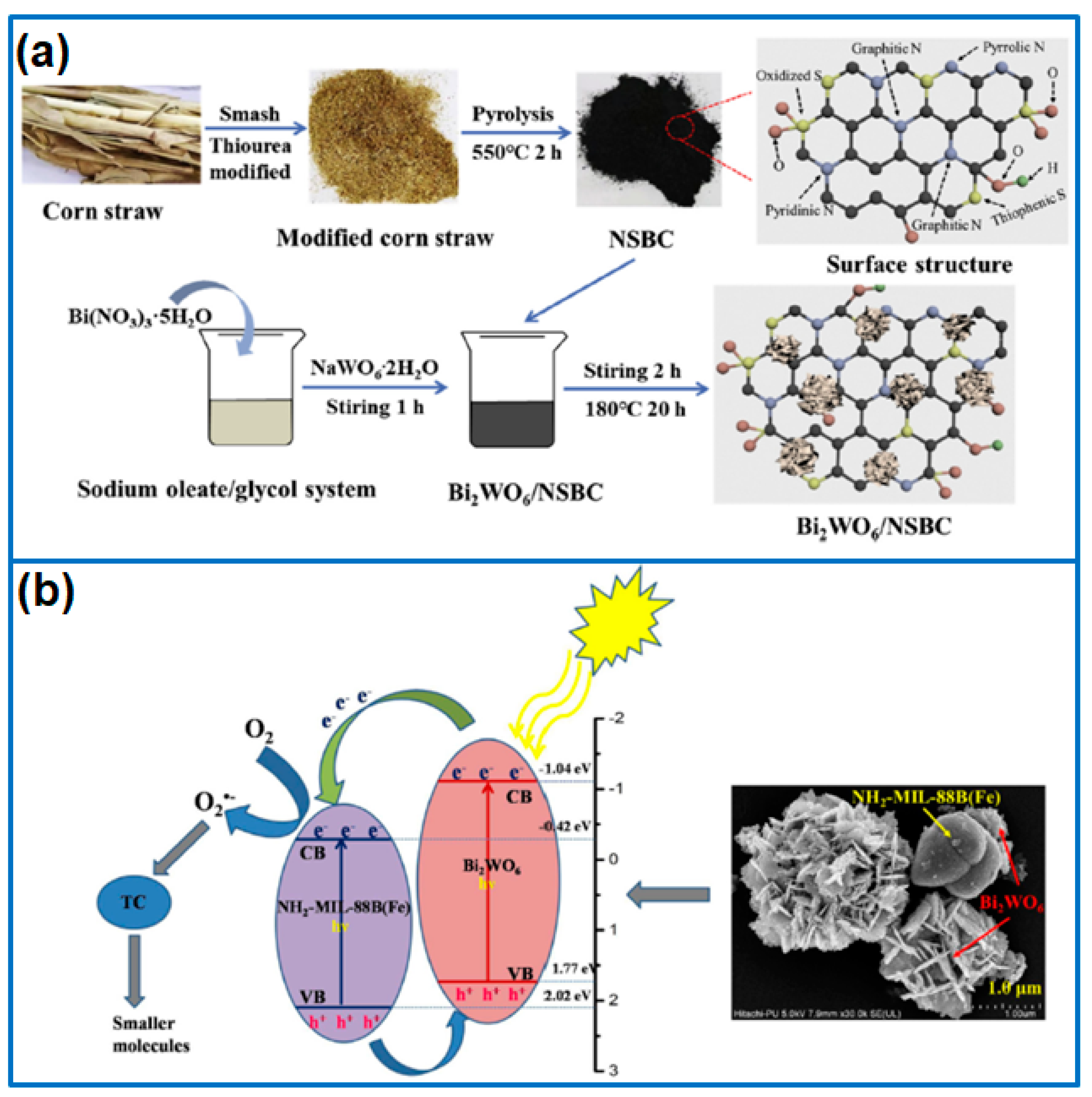
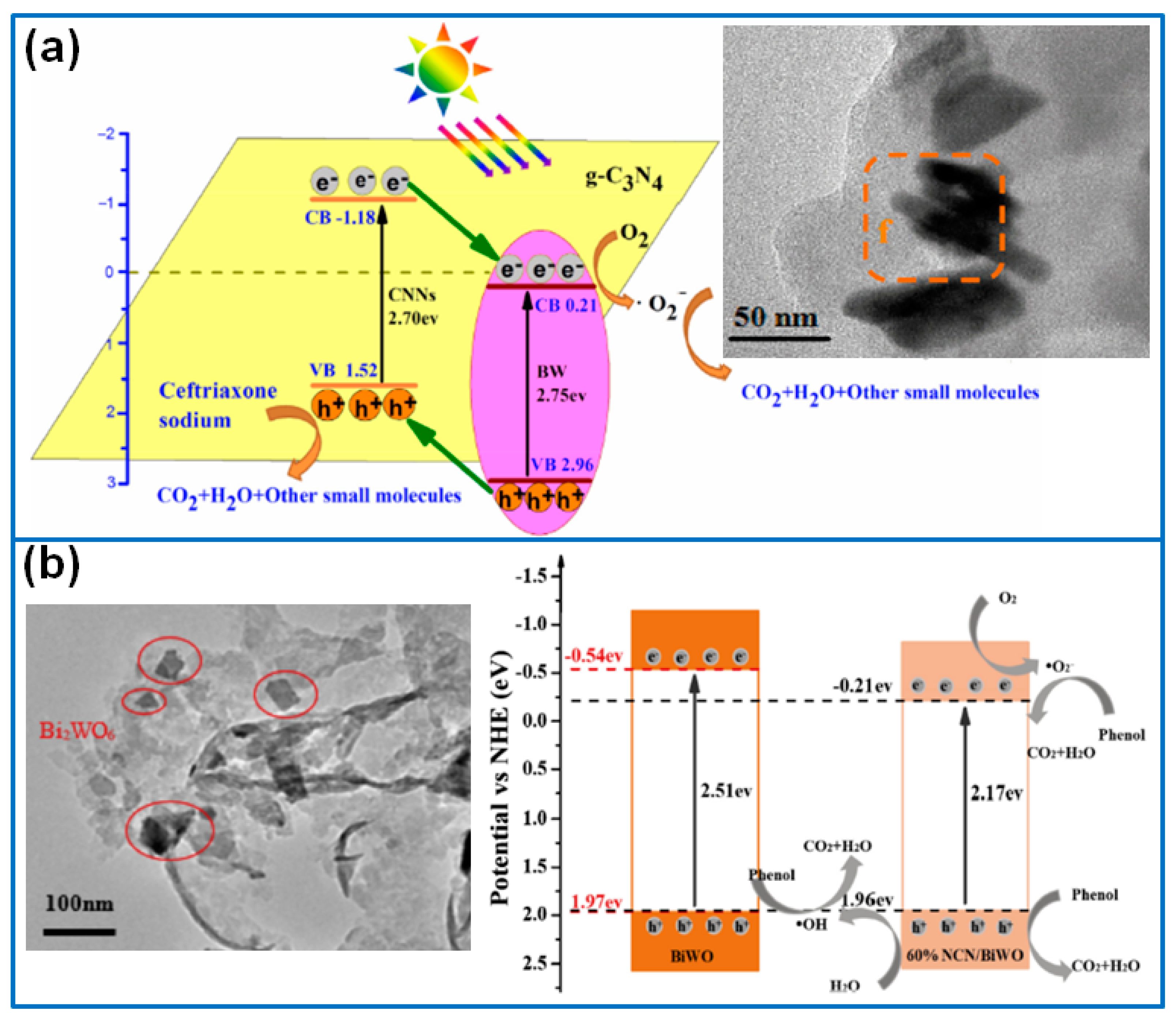

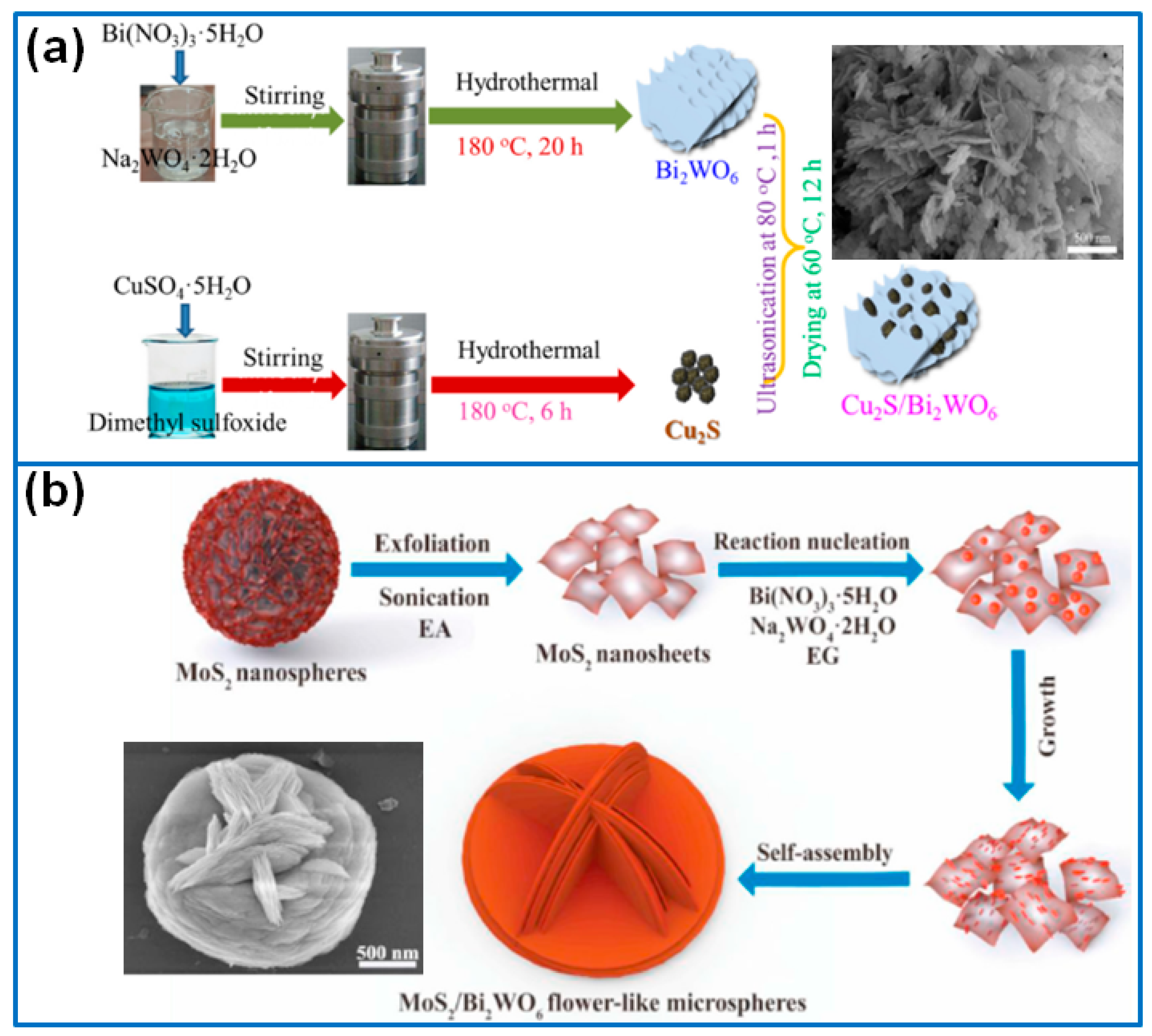
Publisher’s Note: MDPI stays neutral with regard to jurisdictional claims in published maps and institutional affiliations. |
© 2022 by the authors. Licensee MDPI, Basel, Switzerland. This article is an open access article distributed under the terms and conditions of the Creative Commons Attribution (CC BY) license (https://creativecommons.org/licenses/by/4.0/).
Share and Cite
Jiang, H.; He, J.; Deng, C.; Hong, X.; Liang, B. Advances in Bi2WO6-Based Photocatalysts for Degradation of Organic Pollutants. Molecules 2022, 27, 8698. https://doi.org/10.3390/molecules27248698
Jiang H, He J, Deng C, Hong X, Liang B. Advances in Bi2WO6-Based Photocatalysts for Degradation of Organic Pollutants. Molecules. 2022; 27(24):8698. https://doi.org/10.3390/molecules27248698
Chicago/Turabian StyleJiang, Haiyan, Jiahua He, Changyi Deng, Xiaodong Hong, and Bing Liang. 2022. "Advances in Bi2WO6-Based Photocatalysts for Degradation of Organic Pollutants" Molecules 27, no. 24: 8698. https://doi.org/10.3390/molecules27248698
APA StyleJiang, H., He, J., Deng, C., Hong, X., & Liang, B. (2022). Advances in Bi2WO6-Based Photocatalysts for Degradation of Organic Pollutants. Molecules, 27(24), 8698. https://doi.org/10.3390/molecules27248698





